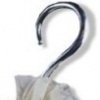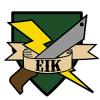- Front-weight darts to make them stable.
- Make darts consistently. Keep the shape consistent. Keep the mass consistent (and measure it to check).
- Make darts well.
- Use systems that remove human variation from the gun, like piloted valve systems (i.e. "backpressure tanks").
- Increase the dart mass.
- Increase the muzzle velocity.
- Use a stiff barrel.
- Use a sight.
- Use the barrel length that maximizes performance.
-----
In light of some recent discussion of rifling as a potential cure for inaccuracy and imprecision of Nerf darts, I decided that we should discuss how to actually improve accuracy and precision. It's a shame that so much effort has been focused into rifling, which probably can't work. Let's focus on what stands a good chance of working.
(I have already explained why rifling most Nerf darts probably can't have any significant good effect and how tests so far have only shown that rifling doesn't seem to improve precision or range.)
Wikipedia has a good page about the difference between accuracy and precision. Basically, accuracy is how close the darts are to their intended target and precision is the spread around where the darts hit.
What is most central to accuracy and precision is repeatability. We want the trajectories to be as consistent as possible between shots. Consequently, we'll be looking to eliminate sources of variation.
Dart stability seems to be necessary for high accuracy and high precision. Stability here refers to resistance against overturning or perhaps even fishtailing. If a dart overturns of fishtails significantly, it is subject to aerodynamic forces that are inconsistent from shot to shot, so the accuracy and precision are affected greatly. The range is generally also very significantly affected.
We know that front-weighted darts have their center of gravity far in front of the center of pressure (where the net aerodynamic forces act), and this leads to stable darts. The darts rotate about their center of gravity, so when the center of gravity is basically at the tip of the dart, the dart basically can only move the length of the dart into the air stream. This applies a force that will rotate the dart back until it is parallel to the flow. This is why front-weighted darts are stable. If they started to become unstable, they'd correct themselves.
There are many other sources of variation that are worth looking in to. We want to ensure that darts are consistent. A few things to keep consistent: dart masses, weight distributions, and drag characteristics. The weight distribution can be kept consistent by using the same materials for all darts and carefully positioning and sizing all of the dart materials. The drag characteristics basically are shape of the dart; we don't want some darts to be bent, have different tips, have hot glue sticking off one end for some darts, etc. Here's the short version: making better and more consistent darts will help accuracy and precision.
Another source of variation is muzzle velocity. If your gun shoots strong on one shot and weak on the next, then obviously where you aimed for the first shot is probably not where your dart will land for the second. Muzzle velocity can be made more consistent by identifying sources of variation in the gun-dart system. Dart mass must be kept consistent here again. If a valve is used, it's better to use a piloted valve as they open basically instantaneously and the time to open is relatively independent of how quickly the user pulls the trigger. If a spring gun is being engineered, try to design the system to make the catch release at the same rate regardless of how quickly the user pulls the trigger. I could go on; you get the idea.
The actual dart mass is also important in addition to its consistency. Heavier darts are more resistant to wind and other transient forces that will push your darts off course. This, unfortunately, conflicts with some people's safety guidelines, but perhaps those guidelines can change in the future.
The actual muzzle velocity is also important for similar reasons. Higher muzzle velocities can lead to lower transit time (the time from leaving the barrel until hitting the target) for the dart, which should reduce the total impulse applied to the dart from transient forces like wind. And as we know, lower impulses mean lower changes in momentum, which means the dart will be more on target. Of course, the muzzle velocities could increase so much that drag causes the transit time to increase. I think this is an area where we need to do some testing before figuring out what works well. Increasing muzzle velocity could potentially counteract some of the limitations in accuracy and precision seen with dart mass restrictions.
The Spud Wiki's page on spudgun accuracy notes that barrel vibrations can cause inaccuracies. I recall this being mentioned on some real gun ballistics websites too. I'm not too sure how significant this effect is for Nerf, but it might be more pronounced for more flexible barrel materials like PETG. A few tests to see if the barrel stiffness (the product of the modulus of elasticity and the second moment of area) has an effect on accuracy seem to be justified. I have a table listing the stiffnesses of some common barrel materials.
A number of other things on the gun can be changed to improve accuracy and precision. Sights are an obvious addition. Simple iron sights are plenty adequate for most Nerf guns, though, I am intrigued by the possibility of using ladder sights with angled shots, but that's for another post. The sight radius, the distance between the front and back sights, can also be increased to allow you to be more precise when aiming. Longer sight radii make aiming errors more noticeable.
These are the main things I'm considering when looking to improve accuracy and precision. Does anyone have any other ideas or thoughts?
I think we'll have to do a lot of testing to figure out some other things. I'm curious about the relationship between precision, dart mass, and muzzle velocity. I had planned to do some tests to determine this relationship last summer but I never got around to it.
Edited by Doom, 27 April 2011 - 09:09 AM.



















